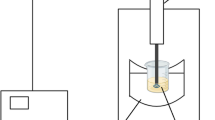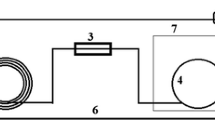Abstract
Based on the fully automatic headspace solid-phase microextraction (HS-SPME)/gas chromatography-mass spectrometry (GC-MS) and multivariate statistical methods, a novel model of identifying and evaluating the quality of Yunnan Pu-erh green tea was constructed for the first time in this work. Twelve Pu-erh green teas from 12 typical production sites of Pu-erh district in Yunnan Province and 6 regular green teas from Zhejiang, Sichuan, Anhui, Henan, Hubei, and Jiangsu provinces of China were used to construct the model. Data from 18 green tea samples by GC-MS were processed with fingerprint technology and chemometric methods. The GC-MS fingerprints from 12 Pu-erh green teas whose correlation coefficients and congruence coefficients were over 0.850 and demonstrated Pu-erh green tea samples from different production sites in Yunnan were consistent to some extent in spite of slightly different chemical indexes. A total of 77 volatile compounds were identified in 18 green teas, mainly including linalool, linalool oxides, phytol, caffeine, geraniol, and dihydroactinidiolide, and their chemical compositions were slightly similar. Cluster analysis (CA) and principal component analysis (PCA) demonstrated that 12 Pu-erh green teas could be clearly distinguished from other six regular green teas according to their chemical characteristics. Our results thus indicate that the chromatographic fingerprint combined with multivariate statistical techniques is useful for the identity and consistency evaluation of Pu-erh green teas. Such an approach is believed to be equally applicable to other green teas.





Similar content being viewed by others
References
Alasalvar C, Topal B, Serpen A, Bahar B, Pelvan E, Gökmen V (2012) Flavor characteristics of seven grades of black tea produced in Turkey. J Agric Food Chem 60:6323–6332
Arisseto A, Vicente E, Furlani R, Pereira A, Figueiredo Toledo M (2013) Development of a headspace-solid phase microextraction-gas chromatography/mass spectrometry (HS-SPME-GC/MS) method for the determination of benzene in soft drinks. Food Anal Methods 6:1379–1387
Byju K, Anuradha V, Rosmine E, Kumar NC, Nair SM (2013) Chemical characterization of the lipophilic extract of Hydrilla verticillata: a widely spread aquatic weed. J Plant Biochem Biotechnol 22:304–311
Chen Y, Zhu SB, Xie MY, Nie SP, Liu W, Li C, Gong XF, Wang YX (2008) Quality control and original discrimination of Ganoderma lucidum based on high-performance liquid chromatographic fingerprints and combined chemometrics methods. Anal Chim Acta 623:146–156
Cirlini M, Caligiani A, Palla L, Palla G (2011) HS-SPME/GC–MS and chemometrics for the classification of Balsamic Vinegars of Modena of different maturation and ageing. Food Chem 124:1678–1683
Dorta E, González M, Lobo MG, Sánchez-Moreno C, de Ancos B (2014) Screening of phenolic compounds in by-product extracts from mangoes (Mangifera indica L.) by HPLC-ESI-QTOF-MS and multivariate analysis for use as a food ingredient. Food Res Int 57:51–60
Du L, Wang C, Li J, Xiao D, Li C, Xu Y (2012) Optimization of headspace solid-phase microextraction coupled with gas chromatography–mass spectrometry for detecting methoxyphenolic compounds in Pu-erh tea. J Agric Food Chem 61:561–568
Hakimzadeh N, Parastar H, Fattahi M (2014) Combination of multivariate curve resolution and multivariate classification techniques for comprehensive high-performance liquid chromatography-diode array absorbance detection fingerprints analysis of Salvia reuterana extracts. J Chromatogr A 1326:63–72
Hu B, Wang L, Zhou B, Zhang X, Sun Y, Ye H, Zhao L, Hu Q, Wang G, Zeng X (2009) Efficient procedure for isolating methylated catechins from green tea and effective simultaneous analysis of ten catechins, three purine alkaloids, and gallic acid in tea by high-performance liquid chromatography with diode array detection. J Chromatogr A 1216:3223–3231
Huo D, Wu Y, Yang M, Fa H, Luo X, Hou C (2014) Discrimination of Chinese green tea according to varieties and grade levels using artificial nose and tongue based on colorimetric sensor arrays. Food Chem 145:639–645
Ivosev G, Burton L, Bonner R (2008) Dimensionality reduction and visualization in principal component analysis. Anal Chem 80:4933–4944
Jin Y, Liang T, Fu Q, Xiao YS, Feng JT, Ke YX, Liang XM (2009) Fingerprint analysis of Ligusticum chuanxiong using hydrophilic interaction chromatography and reversed-phase liquid chromatography. J Chromatogr A 1216:2136–2141
Jumtee K, Komura H, Bamba T, Fukusaki E (2011) Predication of Japanese green tea (Sen-cha) ranking by volatile profiling using gas chromatography mass spectrometry and multivariate analysis. J Biosci Bioeng 112:252–255
Kong WJ, Zhao YL, Xiao XH, Jin C, Li ZL (2009) Quantitative and chemical fingerprint analysis for quality control of Rhizoma Coptidis chinensis based on UPLC-PAD combined with chemometrics methods. Phytomedicine 16:950–959
Kuo KL, Weng MS, Chiang CT, Tsai YJ, Lin-Shiau SY, Lin JK (2004) Comparative studies on the hypolipidemic and growth suppressive effects of oolong, black, pu-erh, and green tea leaves in rats. J Agric Food Chem 53:480–489
Lambert JD, Elias RJ (2010) The antioxidant and pro-oxidant activities of green tea polyphenols: a role in cancer prevention. Arch Biochem Biophys 501:65–72
Lee JY, Yu SM, Sim HJ, Ko SK, Hong J (2013) Comparative profiling of volatile composition from different Acorus species by solid-phase microextraction-gas chromatography/mass spectrometry. Anal Methods 5:3675–3687
Lin J, Dai Y, Guo Y, Xu H, Wang X (2012) Volatile profile analysis and quality prediction of Longjing tea (Camellia sinensis) by HS-SPME/GC-MS. J Zhejiang Univ Sci B 13:972–980
Liu T, Xie J, Zhao J, Song G, Hu Y (2014) Magnetic chitosan nanocomposite used as cleanup material to detect chloramphenicol in milk by GC-MS. Food Anal Methods 7:814–819
Lv HP, Zhong QS, Lin Z, Wang L, Tan JF, Guo L (2012) Aroma characterisation of Pu-erh tea using headspace-solid phase microextraction combined with GC/MS and GC–olfactometry. Food Chem 130:1074–1081
Lv S, Wu Y, Li C, Xu Y, Liu L, Meng Q (2014a) Comparative analysis of Pu-erh and Fuzhuan teas by fully automatic headspace solid-phase microextraction coupled with gas chromatography-mass spectrometry and chemometric methods. J Agric Food Chem 62:1810–1818
Lv SD, Wu YS, Zhou JS, Lian M, Meng Q (2014b) Analysis of aroma components of dark teas from five different production regions by fully automatic headspace solid-phase microextraction coupled with gas chromatography-mass spectrometry. J Chem Pharm Res 64:246–253
Ma C, Dastmalchi K, Flores G, Wu SB, Pedraza-Peñalosa P, Long C, Kennelly EJ (2013) Antioxidant and metabolite profiling of North American and neotropical blueberries using LC-TOF-MS and multivariate analyses. J Agric Food Chem 61:3548–3559
Peng L, Wang Y, Zhu H, Chen Q (2011) Fingerprint profile of active components for Artemisia selengensis Turcz by HPLC–PAD combined with chemometrics. Food Chem 125:1064–1071
Pongsuwan W, Fukusaki E, Bamba T, Yonetani T, Yamahara T, Kobayashi A (2006) Prediction of Japanese green tea ranking by gas chromatography/mass spectrometry-based hydrophilic metabolite fingerprinting. J Agric Food Chem 55:231–236
Pongsuwan W, Bamba T, Harada K, Yonetani T, Kobayashi A, Fukusaki E (2008) High-throughput technique for comprehensive analysis of Japanese green tea quality assessment using ultra-performance liquid chromatography with time-of-flight mass spectrometry (UPLC/TOF MS). J Agric Food Chem 56:10705–10708
Qiao Y, Xie B, Zhang Y, Zhang Y, Fan G, Yao X, Pan S (2008) Characterization of aroma active compounds in fruit juice and peel oil of Jinchen sweet orange fruit (Citrus sinensis (L.) Osbeck) by GC-MS and GC-O. Molecules 13:1333–1344
Schuh C, Schieberle P (2006) Characterization of the key aroma compounds in the beverage prepared from Darjeeling black tea: quantitative differences between tea leaves and infusion. J Agric Food Chem 54:916–924
Serpen A, Pelvan E, Alasalvar C, Mogol BA, Yavuz HT, Gökmen V, Özcan N, Özçelik B (2012) Nutritional and functional characteristics of seven grades of black tea produced in Turkey. J Agric Food Chem 60:7682–7689
Song M, Li Q, Guan X, Wang T, Bi K (2012) Novel HPLC method to evaluate the quality and identify the origins of Longjing green tea. Anal Lett 46:60–73
Song S, Zhang X, Hayat K, Xiao Z, Niu Y, Eric K (2013) Coordinating fingerprint determination of solid-phase microextraction/gas chromatography-mass spectrometry and chemometric methods for quality control of oxidized tallow. J Chromatogr A 1278:145–152
Wang LF, Lee JY, Chung JO, Baik JH, So S, Park SK (2008) Discrimination of teas with different degrees of fermentation by SPME–GC analysis of the characteristic volatile flavour compounds. Food Chem 109:196–206
Wang Y, Li Q, Wang Q, Li Y, Ling J, Liu L, Chen X, Bi K (2011) Simultaneous determination of seven bioactive components in oolong tea Camellia sinensis: quality control by chemical composition and HPLC fingerprints. J Agric Food Chem 60:256–260
Wang L, Wei K, Cheng H, He W, Li X, Gong W (2014) Geographical tracing of Xihu Longjing tea using high performance liquid chromatography. Food Chem 146:98–103
Wu SB, Dastmalchi K, Long C, Kennelly EJ (2012) Metabolite profiling of Jaboticaba (Myrciaria cauliflora) and other dark-colored fruit juices. J Agric Food Chem 60:7513–7525
Wu SB, Meyer RS, Whitaker BD, Litt A, Kennelly EJ (2013) A new liquid chromatography-mass spectrometry-based strategy to integrate chemistry, morphology, and evolution of eggplant (Solanum) species. J Chromatogr A 1314:154–172
Yang J, Maldonado-Gómez MX, Hutkins RW, Rose DJ (2013a) Production and in vitro fermentation of soluble, non-digestible, feruloylated oligo- and polysaccharides from maize and wheat brans. J Agric Food Chem 62:159–166
Yang Z, Baldermann S, Watanabe N (2013b) Recent studies of the volatile compounds in tea. Food Res Int 53:585–599
Yang Y, Li H, Zhang J, Sun N, Sun H (2014) Analysis of infant formula for steroid hormones by gas chromatography–tandem mass spectrometry using microwave-assisted extraction and gel permeation chromatography clean up. Food Anal Methods 7:798–805
Ye N, Zhang L, Gu X (2012) Discrimination of green teas from different geographical origins by using HS-SPME/GC–MS and pattern recognition methods. Food Anal Methods 5:856–860
Yi L, Liang Y, Wu H, Yuan D (2009) The analysis of Radix Angelicae sinensis (Danggui). J Chromatogr A 1216:1991–2001
Zhao M, Ma Y, Wei ZZ, Yuan WX, Li YL, Zhang CH, Xue XT, Zhou HJ (2011a) Determination and comparison of γ-aminobutyric acid (GABA) content in pu-erh and other types of Chinese tea. J Agric Food Chem 59:3641–3648
Zhao Y, Chen P, Lin L, Harnly JM, Yu L, Li Z (2011b) Tentative identification, quantitation, and principal component analysis of green pu-erh, green, and white teas using UPLC/DAD/MS. Food Chem 126:1269–127
Acknowledgments
This work was supported by the National Natural Science Foundation of China (No.3100960) and Natural Science Foundation of Yunnan Province (No.2010ZC054).
Conflict of Interest
Shi-Dong Lv declares that he has no conflict of interest. Yuan-Shuang Wu declares that she has no conflict of interest. Yu-Zhu Song declares that he has no conflict of interest. Jiang-Sheng Zhou declares that he has no conflict of interest. Ming Lian declares that she has no conflict of interest. Chen Wang declares that he has no conflict of interest. Lun Liu declares that he has no conflict of interest. Qing-Xiong Meng declares that he has no conflict of interest. This article does not contain any studies with human or animal subjects.
Author information
Authors and Affiliations
Corresponding author
Rights and permissions
About this article
Cite this article
Lv, SD., Wu, YS., Song, YZ. et al. Multivariate Analysis Based on GC-MS Fingerprint and Volatile Composition for the Quality Evaluation of Pu-Erh Green Tea. Food Anal. Methods 8, 321–333 (2015). https://doi.org/10.1007/s12161-014-9900-0
Received:
Accepted:
Published:
Issue Date:
DOI: https://doi.org/10.1007/s12161-014-9900-0




